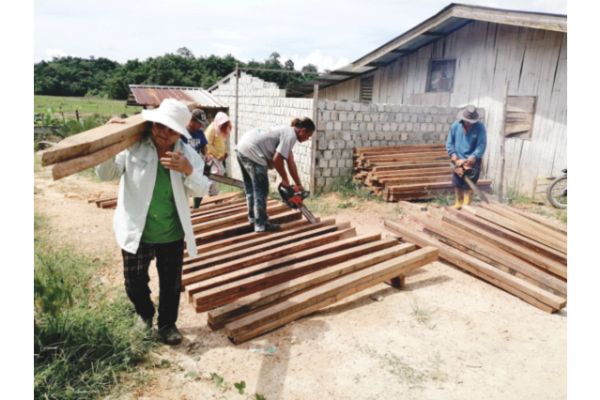Padi farms being revived but buffaloes problem
Published on: Tuesday, October 27, 2020
 Tinuhun Gotong-Royong making fences to control buffaloes.
Tinuhun Gotong-Royong making fences to control buffaloes.
Kota Kinabalu: The current Movement control Orders to prevent the spread of Covid-19 and supermarkets limiting consumers to only one pack of 10kg rice per person is prompting once padi growing communities to revive idle lands. The villagers of Tinuhan and neighbouring Lapasan Ulu decided to go back to growing their own padi and huge efforts have been made to bring old padi fields back to production, including repairing irrigation and drainage system , constructing ridges , flattening and terracing the area since June 2020.
ADVERTISEMENT
So far, 39 families have planted rice of delicious and nutritious varieties, with credit citing a raft of support for the project from Yayasan Hasanah, Kampong Campus, Sapulut Forest Development in Kalabakan and DID Sabah.
Sabah now produces only a quarter of the rice it consumed. For nearly 30 years the State Government has been trying and failing to reach the 60pc self sufficiency level.
But unlike the old days when they were treasured as beasts of burden to do the ploughing, farmers are facing the prospect of buffaloes eating up the young padi shoots.

Tinuhun’s buffaloes apparently thinking of eating rice after a day eating grass and rolling in mud.
Buffaloes were once regarded as the key to rice production in North Borneo and the best ploughing friend of padi farmers.
ADVERTISEMENT
A press release from Leap (Land Empowerment Animal People) suggested the surprise turn of opinion on the ground, though the animal, itself, is blameless but a victim of mechanisation.
Whereas “buffaloes and the production of rice were once closely intertwined, wholly useful like ploughing, hauling, naturally manuring the fields with their droppings, grazing up residue crops, helped threshed rice,” it says, they have now purportedly become enemies by doing the opposite!
ADVERTISEMENT
Citing the “frustration and exasperation” of villagers of Kg Tinuhan 3km from Tanghilan township, it asserts “ since tractors and other machinery took over in the 1980s, buffaloes are now in the field not ploughing but “eating the growing rice” which apparently tastes much better than the “sour saimah malas” grass that grows in abandoned paddy lands.
“In addition, the farmers suffer damage to their culverts, ridges, drains and fences, as the bovids trample happily around the field. Heart broken, many farmers have given up,” the statement asserts.
It is not clear whether this is a statewide issue.
“When Covid-19 came and threatened imports, the buffalo problem became part of the State’s emergency.”
Part of the problem is inaction.
“I have contacted the police, the animal services department, the agriculture department and the surrounding village heads to discuss how to overcome this problem but it does not bring any change,” sad Lombuti Senteri, Tinujan’s Village Chief.
A meeting between the project managers, village chief, MPKK got a representative from the Animals Services Department named Freed to look at provisions of livestock law and regulations which paved the way to control of the buffalo problem in future especially holding buffalo owners accountable.Stay up-to-date by following Daily Express’s Telegram channel.
Daily Express Malaysia











